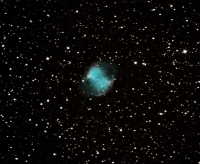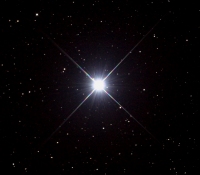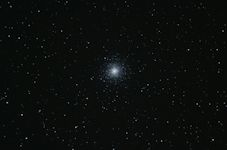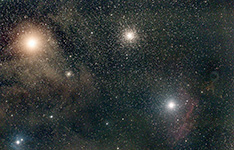

This world of wonders pales before the vastness and grandeur of the cosmos. There are echoes from the beginning of time and portent of a distant future when humankind will travel among the stars. When I gaze into the heavens, I see both boundaries of eternity.

Feedback: rick.whitten@quadradical.com
|
Astrophotography |
||||
| Messier Objects | Other Catalogs | Solar System | ||
|
|
|

|
||
| By Constellation | By Object Type | By Date | ||

|

|

|
||
Science and Religion - a matter of honesty and respect
I presented a talk at our astronomy club in January about how Clair Cameron Patterson, an Iowan, accurately measured the age of the solar system at 4.56 billion years, publishing his result in 1956. Although I was raised in an evangelical church which taught young earth creationism, forty seven years later I find that I am somewhat surprised that 38% of Americans still believe that the earth is 6,000 to 10,000 years old....read more
Let's Get Our Bearings
The celestial sphere has a coordinate system that, at first glance, seems just a bit esoteric. For example, Betelgeuse has coordinates 5 hours, 55 minutes by +7 degrees and 24 minutes (5h55m, +7°24'). That doesn't really seem like very useful knowledge. So let's get to know this system a bit....read more
Rare Elements
If you look up any chemical element at Wikipedia, the article will likely tell you how it was synthesized by stars, produced by supernovae, spallation, or radioactive decay. This reasoning generally explains the relative abundance of elements both here on Earth and in space....read more
Climate Change? Rely on the Experts
One Hundred and Ninety years ago, French mathematician and physicist Joseph Fourier published an article noting that given the Earth - Sun distance and the solar irradiance, the Earth should be cooler than it actually is. He suggested that the Earth's atmosphere acted to insulate the surface. In other words, Fourier first proposed the greenhouse effect. ..read more
The Next Supernova is Signaling Us, But We Can't See
The last supernova visible in our galaxy was Kepler's supernova in 1604. On average, there should be about two supernovas a century in the Milky Way. So we are overdue. Today a supernova in our galaxy would trigger an early alert system; perhaps several hours before any light reached Earth....read more
SN 2014J
Eleven and a half million light years away and eleven and a half million years ago a type Ia supernova exploded in Messier 82, or the Cigar Galaxy. The first light showed up here about January 15 or 16. Some one finally noticed it on January 21st....read more
The First Messier Object
It was July 4th 959 years ago, a couple hours before sunrise. The moon was thin sliver about 20 degrees above the horizon. A glow in the east heralded a coming dawn. But between the sun and moon was a new star, blazing three times brighter than Venus. And for 23 days, this guest star was visible in the daytime sky.....read more
Uncommonly Bright
The ten brightest stars in our northern skies are: Sirius, Arcturus, Vega, Capella, Rigel, Procyon, Betelguese, Altair, Aldebaran, and Spica. Of the ten only four are bright because they are close and they are the only four main sequence stars. The majority of bright stars are rather far away and are anything but typical..... read more
There's Something Hiding in the Dark
There something strange out there in the darkness -- a whole lot of it and it is a whole lot of strange. When astronomers first measured the speed of stars in our own galaxy and our nearby neighbors they knew something was off. The outer parts of galaxies rotated too fast compared to the visible stars and gas in galaxies.... read more
The Local Group
Our Milky Way's home in the sky is "The Local Group". It is composed of a trio of galaxies and about 50 dwarf galaxies. The Milky Way's big brother is the Andromeda Galaxy (M31) with more than twice as many stars and 25% more mass. The third galaxy is the Triangulum Galaxy or Messier Object 33 with half the radius and one tenth the mass ... read more
Og's Rock
Science is about making sense of the world around us by discovering the rules of the road. Verifying theories is where scientific rubber meets the road and for that we must make measurements. We have a nice system of international units used by every civilized nation to perform these measurements, but it hasn't always been so. ...read more
Earthling Aliens
In a previous article -- Is anybody out there? I discussed the Fermi paradox, and using my best guesses and back of the envelope calculatons, suggested it would take no longer than 100 million years for us to colonize the disk of our galaxy. Herein I offer more musings about our ultimate endeavor... read more
An Atheist's Prayer
When one gazes into the heavens and beholds the wonders of the universe, it seems almost reasonable to have religious ponderings. But it is not reasonable. Astronomy is the enemy of traditional religions in many respects because it answers the question "How did we all get here?" and "Where did everything come from?".Read More
Is Anybody Out There?
Maybe not. When Enrico Fermi and associates casually mused about the probability of extra-terrestrial intelligence, Fermi asked "Where are they?" He quickly calculated that they should have been here by now and yet they are not. This is known as the Fermi paradox.... Read More
Potentially Hazardous Objects
Next year another comet will visit the inner solar system for the first and last time -- C/2013 A1. The people on your TV set will incorrectly refer to it as Siding Springs, which is the group that discovered it. On October 19, 2014 it will pass about 70,000 miles of Mars. The margin of error allows for a small, but non-zero chance of collision with Mars. Read More
Two Newcomers from Oort
Comet C/2011 L4 or as the media mistakenly calls it -- PANSTARRS is making its debut in the inner solar system. I haven't managed to get a picture yet due to cloudy western horizons at dusk. The eccentricity of C2011 L4 is pretty close to one (1.000087). You will recall from the chapter on conic sections which your algebra, trig, and calculus teachers brushed on briefly or skipped completely (you were cheated), Read More
Pin the Dinosaur on the Football Field
The Solar nebula coalesced into the sun and planets about 4.6 billion years. If we were to put the geologic time line onto a football field, where would the age of dinosaurs be? Your instinct is probably wrong, but it's not all your fault. Just as the graphics representing an atom are not to scale, neither are most geologic time-scales. Read More
How Far I Can See?
If we examine the classical equations for gravitation, electrical force, and sound energy at a distance, we find they all have a factor in common: The r2 in the denominators are examples of inverse square laws. It's just a simple matter of geometry. Imagine a point source of light in the center of a sphere with a radius of r. The surface area of the sphere is 4πr2....Read More
Supernovae From Degenerate Stars
Some of the stars that helped create the materials of which we are made did not end their existence as a Type II or core collapse supernovas.
Once a star burns all of the hydrogen in its core to helium, it evolves off the main sequence to become a red giant. This phase is made possible by the fact that adding a proton to a helium atom makes lithium 5 which has a half life of about 400 x 10-24 seconds before decaying ....Read More
We are Stardust
Only the most massive stars in the universe end their lives as core collapse supernovas and stars with requisite mass (above 25 solar masses) are about 1 in 10 million or less. These stars only shine for about 10 million years before ending in a bang. Their demise triggers star birth as shock waves sweep up and compress interstellar gas which becomes a stellar nursery givin birth to an open cluster of new stars. ....Read More
The Color of Stars
A star's life history is determined at birth, the most important factor being mass. Our own sun is an average, run of the mill G class star. When it collapsed under its own weight 4.6 billion years ago, its core got hot enough to start fusing hydrogen to helium via the proton chain reactions. The end result is a helium 4 nucleus that has less mass than 4 protons. The missing mass has been converted to energy. The fusing core heats the sun and supports it against its own gravity ....Read More
Type II Supernovas - a Little Neutrino Burst
On February 23, 1987 the Japanese Neutrino detector at Kamioka mine detected 11 neutrinos within 10 seconds. The ordinary rate at which Kamiokande detected solar neutrinos was less than one a day. As you will recall from Neutrinos, Big Numbers, and Four Forces, ordinary matter is essentially invisible to neutrinos. Recall the football stadium model of the atom. The nucleus was a BB at the 50 meter line. A neutrino interaction may take place if a neutrino goes through the nucleus, but the nucleons are made of quarks. ....Read More
Neutrinos, Big Numbers, and Four Forces
Astronomy is full of atronomically big numbers and big ideas. For example, the nearest star, Proxima Centauri, is 4.24. light years away. A light year is 5.88 trillion miles thus Proxima Centauri is 24,900,000,000,000 miles away. We can short hand such big numbers with exponential notation -- 24.9 X 1012. It can be a bit difficult to conceptualize a number that big, but with the help of a football field we shall take a stab at it....Read More
Location:
41° 57' 52" N x 93° 59' 23" W
Southeast of Ogden, IA

Celestron 11 EdgeHD, 2800mm focal length, EQ-G mount
